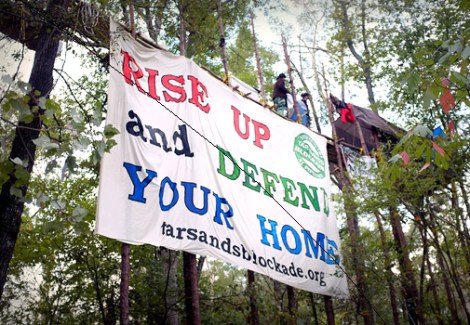A bit of bummer news from East Texas, and this time there’s no pepper spray involved. Protesters are still tweeting and blogging per usual, but it appears the Keystone XL pipeline blockade may actually be over. TransCanada apparently realized back in October that while it might not be able to go through the tree-sitters, it could easily go around them.

Tar Sands Blockade
TransCanada, the pipeline’s builder, acquired an easement in October to build the pipeline slightly west of the tree blockade and the original route. Construction is now nearly finished on the property, and the protesters will soon call it quits.
“It’s a sad time at the tree blockade,” said Ron Seifert, a spokesperson for the Tar Sands Blockade, the activist group behind the campaign. Seifert said it’s probably days before the tree village decamps, though no official decision has been made. …
“As we speak, the pipeline is being trenched around the western end of the blockaded area,” he added with disappointment. The “blockade will essentially become symbolic and come to an end.”
[David] Dodson of TransCanada confirmed that construction is “substantially complete” on the property, which is owned by David Daniel, a longtime opponent of the Keystone XL. Daniel reached an easement agreement with TransCanada in 2010, but later told the company it could no longer come on his property. TransCanada responded with a lawsuit; the two parties have since settled litigation.
It’s unclear what might be next for the protesters. They’ve planned to take on the Texas Railroad Commission tomorrow and train more potential blockaders in early January at a “mass action camp.”
I think David Daniel is the most tragic character in this story, though. He fought TransCanada for years, as The Guardian reported last March:
If the State Department signs off the pipeline, Daniel says, he will build a platform in an elm on his land and live on it. “If I am in it, they can’t cut the tree down.”
This October, The New York Times described him as “a soft-spoken carpenter.” And that tree house?
[Daniel] gazed up at a tree house he built — now being used by the protesters — turned around and walked quietly back toward his home.



